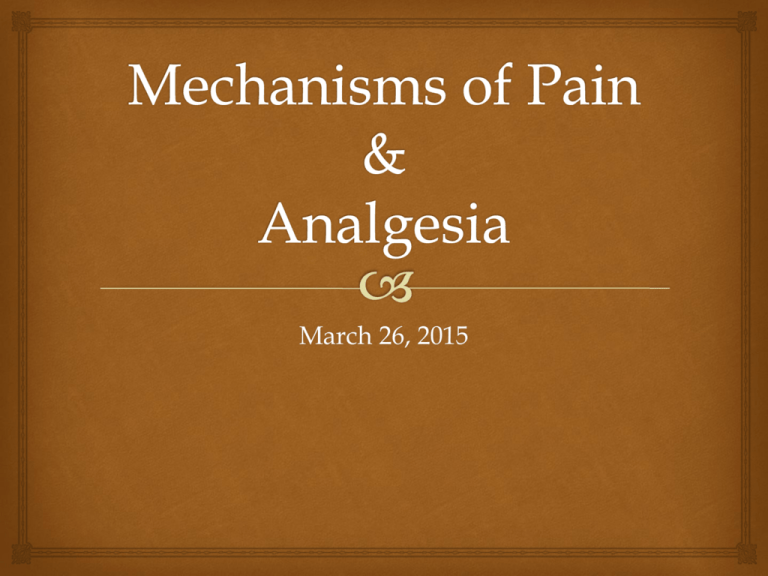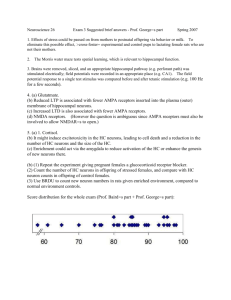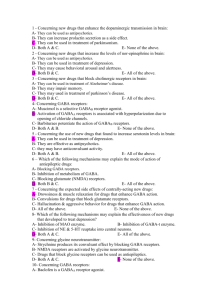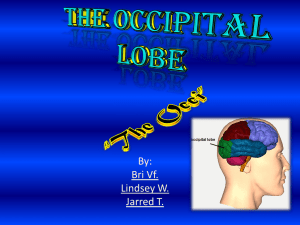Mechanisms of Pain & Analgesia
advertisement

March 26, 2015 Anatomy of Pain Pathways 1 Order: Cell body in st DRG. Unmyelinated, slow C fibers, & thinly myelinated A fibers 2nd Order: Cell body in spinal cordspinothalamic tract 3rd Order: Cell body in thalamus (ex. Ventral posteriolateral nucleus) Pain occurs in the cortex Pain is a product of higher brain processing. Nociception unmodulated by descending pathways, as with cord transection, can lead to autonomic hyperreflexia. Peripheral Receptors Peripheral Receptors Membrane proteins transduce stimuli into electrical impulses. Ex. TRPV1-heat, H+ (ischemia ), & capsaicin. TRPM8-cold, menthol Injury releases inflammatory mediators: H+,K+, bradykinin (activation & sensitization), 5-HT, ATP (purinoreceptors), cytokines (which can act directly on receptors or indirectly by stimulating prostaglandin release), prostaglandins (activation & sensitization via cAMP or Na+ channel thresh hold), & NO, & can activate nociceptors directly or can increase excitation state (inflammatory cascade) at periphery with increased expression of membrane proteins (vanilloid receptor proteins, tetrodotoxin + & Na= channels) Activation of voltage gated Ca+ channels will cause neurotransmitter release. “Sleeping”/”Silent” nociceptors respond only at extreme intensity with wake up in response to endogenous mediators such as bradykinin from cell injury. Peripheral Receptors All nociceptors can be sensitized so activation thresh hold lowered leading to spontaneous firing & hyperalgesia. In response to tissue injury, signals in pain transmission circuits may be enhanced causing hyperinflamatory pain, hyperalgesia & allodynia. Therefore, peri-op pain treatment should be directed at interfering with development of hyperalgesia. 1/3 of chronic pain patient cite surgery as initiating cause. 2nd Order Nociception Neurons 1st order fibers innervate nociceptor in lamina 1 & 2. Cells in 2 make connections with in 5-7. Both give rise to spinothalamic tracts. These can be modulated by descending fibers. Presynaptic Modulation Presynaptic Modulation Pre-Synaptic Modulation Endogenous Opioids: Dynorphins acting on kappa receptors, Enkephalins on delta, Endorphins on mu & delta. (more or less). Inhibit Ca+ influx and open K+ channels to hyperpolarize neurons. Nociceptin: opioid like, also acts on directly on dopamine receptors or indirectly via inhibition of GABA Alpha-2 agonists decrease sympathetic output via negative feedback, modulates release of substance P and epinephrine. 3rd Order Neurons 2nd order synapse to 3rd order in thalamus nuclei (Medial Dorsal, VMP, VPL, etc.) 3rd order synapse in cingulate, primary somatosensory, & insular cortex Problems with Pain Long standing nerve injury may show little change in descending inhibition while huge increase in facilitation. May lead to chronic pain & allodynia, with 1st order nociceptors releasing increased neurotransmitters such as glutamate & substance P. Inflammatory pain can cause hypersensitivity, enhanced signaling in pain transmission. “Central Sensitization” wherein sustained activation of 1st order neurons produce long lasting changes in spinal excitability Spinoparabrachial-amygdala pathway can affect emotive component of pain, as well as thalamic-anterior cingulate gyrus.(anxiety, chronic pain syndromes) Increasing sensitivity in surrounding cells (ex. Visceral injury leading to muscle & skin pain. ) Injury during neuronal maturation may lead to adult hypersensitivity Multimodal Treatment of Pain Gateway Theory: collaterals of sensory fibers activate inhibitory interneurons & inhibit pain transmission (rational for TENS) Stimulation produced analgesia: stimulation of periaqueductal grey area, nucleus raphe magnus, dorsal raphe, etc. Will inhibit pain. Opiates Obviously, work on endogenous opioid receptors. Especially good for inflammatory hyperalgesia. Presynaptic (& some post synaptic) inhibition of neurotransmitter release by hyperpolarization and opening of K+ channels & closing of Ca+ channels. Currently no opiates that bind to specific opioid receptors, so, for example, can not target mu-1 for analgesia while avoiding mu-2 respiratory depression. Increased intra-op dosing may decrease incidence of postop sensitization. Activation of NMDA may lessen sensitivity of opioid receptor. Local Anesthetics Selectively bind to inactivated-closed Na+ channels on inner (or H gate) of channel. As gates open & close, further binding occurs, so resting nerve less sensitive than stimulated nerve. Are weak bases with pKs of 7.6 to 8.9. Un-ionized form crosses membrane, then ionized in cytoplasm to bind channel. (BiCarb added to increase % of un-ionized form. At pH 7.4, only 5% of tetracaine un-ionized. In acidic infected area less % un-ionized ) Theorized need at least 2 cm of nerve blocked to block transmission. Amides: lidocaine, bupivacaine, ropivacaine metabolized by microsomal enzymes in liver Esters: procaine, chlorprocaine, tetracaine, coccaine undergo hydrolysis by cholinesterases mostly in plasma and some in liver Local Anesthetics Toxicity: Bupivacaine 3 mg/Kg Lidocaine 5 mg/Kg without epinephrine Lidocaine 7 mg/Kg with epinephrine BUT, toxicity dependent on: 1. method of injection: ICE-BS 2. Protein binding: Bupivacaine highly protein bound so increased toxicity in liver failure, neonates, etc., but lidocaine much less bound. Lidocaine: neurologic effects manifest first Bupivacaine: cardiac effects manifest first. Ropivacaine: also has A-V conduction slowing but secondary to steroselective inotropic effects much less cardiodepressive. Increasing fat solubilty slows induction. Increased mass effect speeds induction. Increasing % of un-ionized speeds induction. By blocking nerve conduction, especially abnormal activity in peripheral nerves, hypersensitivity may disappear. Rational for sympathetic nerve blocks NSAIDs Inhibition of COX enzymes with reduction of prostaglandin formation. Decreases inflammatory response to surgery Central inhibition of PGs may also decrease perception of pain. Ketorolac likely potentiates the antinociceptive actions of opioids. Acetaminophen associated with both nephropathy & hepatic necrosis COX-2 inhibitors associated with 40% increase in cardiovascular events: thrombotic events & MI’s Current research with NO releasing derivatives (i.e. nitroaspirin) & direct EP receptor antagonists Alpha-2 Agonists & NMDA blockers Dexmedetomidine: selective alpha-2 adrenergic agonist with pre-synaptic modulation of release of substance P in dorsal horn, decreases central sympathetic output (like clonidine), increases firing of inhibitory neurons, and anxiolytic mainly in locus ceruleus. Minor alpha -1 post synapse Glutamate receptors (n-methyl-d-aspartate=NMDA) are essential to driving pain after inflammation, but are not involved in pain after surgery. Ketamine inhibits NMDA system by blocking open channels, decreasing frequency of channel opening, and decreasing open time. Also regulates epinephrine release. Studies suggest that intrathecal ketamine may decrease pain at 48 hours and at 1 year post op. Capsaicin & Cannabinoids Capsaicin receptor VR-1 ligand-gated, non-selective cation channel in same family as vanilloid, mostly found in small diameter afferent neurons ( but also in CNS ). Responds to moderate heat,~43 degrees, and to H+ Topical applications may “exhaust” neurotransmitters (especially substance P). Also may improve efficacy of local anesthetics by opening channels (stimulation) to return to closed inactivated. Cannabinoids: Endocannabinoid receptors first found in 1988-G-protein coupled affecting cAMP, with synergistic activity between periphery & CNS. Suppress both pain & inflammatory processes. Especially active on glutamatergic , also on GABA synapses. Interact with endorphin & TRPV systems as well. In VPL nucleus of thalamus 10 X more potent than morphine in pain mediating neurons, blocks capsaicin induced hyperalgesia, blocks PG induced inflammation. Gabapentin Similar in structure to GABA, but does not seem to bind to GABA receptors. Main site of action is blockade of voltage gated Ca+ channels Appears to increase GABA synthesis & modulate glutamate synthesis. Works well on diabetic & post herpetic neuralgias & neuropathic pain in general Not as effective on inflammatory pain Multimodal Analgesia Diverse opinion as to whether post operative outcome is improved. Is there as benefit to pre-emptive local anesthesia? Benefit of decreased side effects: Decreased opioid use therefore decreased risk of N/V, decreased GI problems with NSAIDs. Addition of gabapentin decreased opioid use, in arthroplasties improved knee flexion & decreased pain at 6 months Addition of IV or IN ketamine decreased chronic pain at 6 months from 24% to 8% IV dexmedetomidine can increase duration of sensory nerve block. Cannibinoids showing promise in decreasing chronic post op pain.








